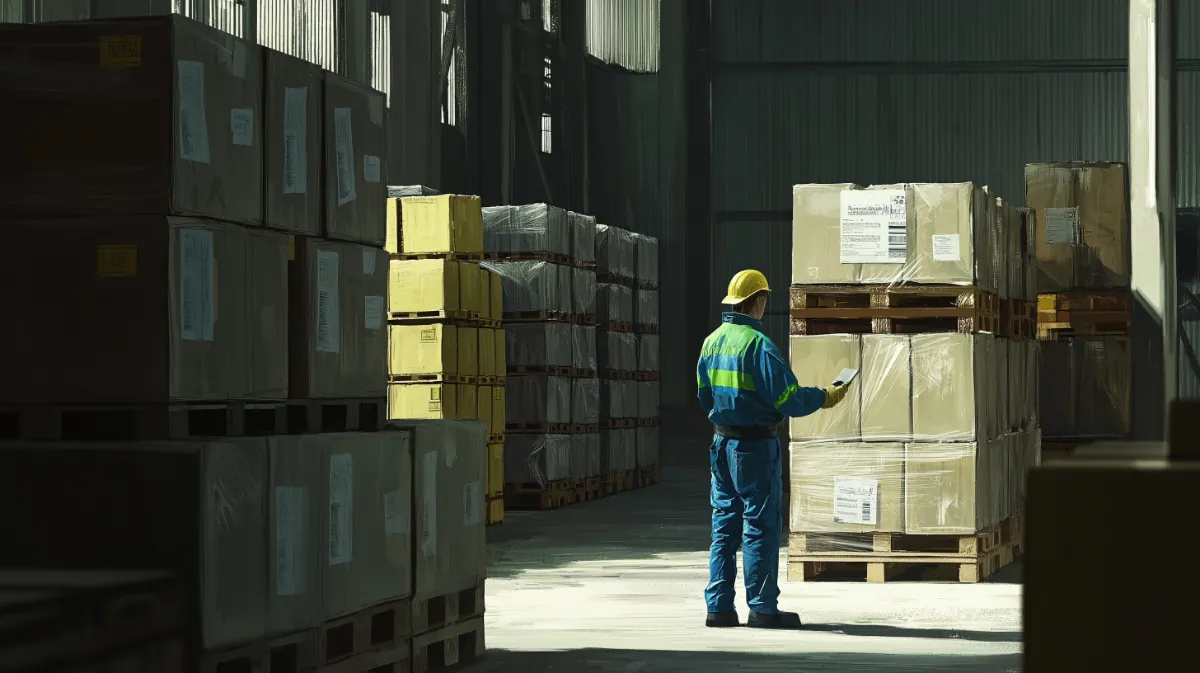
Warehouse Picking Guide: Methods, Technology & Trends
What Is Warehouse Order Picking?
Warehouse order picking is a dynamic, multi‑step process that serves as the critical link between your on‑hand inventory and customer satisfaction. At its core, picking begins when a customer order is released and transforms digital order details into actionable pick lists that guide workers through optimized routes. Pickers then locate each SKU, verify quantities, and stage items for packing and shipping. Every handoff point, from paperless pick confirmations via RF scanners to automated validation through barcode or RFID, must function seamlessly to prevent costly errors and delays. In many operations, picking accounts for over 50 percent of labor expenses and up to 60 percent of total process time, making it the prime lever for cost reduction, throughput gains, and accuracy improvements. As e‑commerce demands faster delivery windows and higher order volumes, the complexity of picking increases. SKU proliferation, narrow fulfillment windows, and labor constraints all raise the stakes. This section lays out the fundamental steps and stakes of warehouse order picking, setting the stage for strategies to streamline each phase of the process.
- Order release: Converting customer orders into pick lists
- Slotting lookup: Identifying the optimal storage location
- Travel: Physically moving through the warehouse
- Picking: Removing items from racks, shelves, or bins
- Verification: Confirming SKU and quantity accuracy
- Consolidation: Staging picks for packing and shipping
Why Order Picking Strategies Matter
Picking strategy is the linchpin that determines how efficiently your warehouse operates under real‑world conditions. With picking often accounting for more than half of total labor costs, choosing the optimal approach directly affects profitability, service speed, and the customer experience. A thoughtful picking strategy aligns order profiles, SKU characteristics, and staffing capabilities, ensuring you deploy the right resources where they make the biggest impact. In some operations, batch or cluster methods can dramatically reduce walking time and boost lines‑per‑hour metrics. In others, zone or wave picking may offer the specialization and scheduling flexibility needed to meet carrier deadlines and labor constraints. Beyond productivity gains, the right strategy minimizes errors that trigger costly returns and reputational damage, while providing the scalability to handle seasonal peaks without a proportional increase in headcount. It also influences capital decisions, from investing in automation and picking technologies to configuring your facility layout and slotting logic. In this section, we explore why picking strategy is not a one‑size‑fits‑all choice but rather a customizable framework that, when executed well, transforms picking from a labor‑intensive bottleneck into a strategic advantage that differentiates your fulfillment operation.
A well‑chosen picking strategy:
- Reduces labor costs by cutting unnecessary travel and idle time
- Minimizes errors, lowering returns, rework, and customer complaints
- Improves throughput, allowing more orders per shift without adding headcount
- Enhances scalability, adapting to peaks without breaking the budget
- Boosts customer satisfaction, leading to repeat business and positive reviews
Poorly designed picking processes, by contrast, lead to bottlenecks, overtime expenses, and damaged brand reputation. The right strategy aligns order profiles, SKU characteristics, workforce capabilities, and technology investments.
In‑Depth Order Picking Methods and When to Use Them
Choosing the right picking method is foundational to operational efficiency and accuracy. This section delves into nine core approaches, each with its own mechanics, benefits, and trade‑offs, so you can match method to your facility’s order volume, SKU diversity, and workforce profile. We begin with simple manual techniques like discrete single‑order picking that suit small operations, then explore batch and cluster methods that improve throughput by grouping picks. Next, we examine zone, pick‑and‑pass, and wave picking strategies that introduce specialization and flexible scheduling. For bulk and high‑velocity operations, we discuss pallet picking and advanced goods‑to‑person automation, highlighting how robotics and conveyors can slash travel time and elevate consistency. Finally, combined and hybrid models show you how to tailor processes across product segments and seasons. Real‑world examples and decision criteria guide you through selecting, piloting, and scaling the optimal method mix for your unique operation.
Discrete (Single‑Order) Picking
Definition
One picker fulfills one order at a time, traveling the warehouse to collect each SKU.
Pros
- Simple to implement; minimal system requirements
- High accuracy for small operations
Cons
- Inefficient at scale; travel time dominates
- Poor utilization of picker capacity
Best for
Custom or high‑value products, small SKU counts (under 500 SKUs), limited order volumes.
Batch Picking
Batch picking organizes the fulfillment process by grouping multiple orders that share common SKUs or locations into a single picking run. Instead of repeatedly walking to the same storage area for each individual order, batch picking enables a picker to collect all required units for several orders in one go, drastically reducing travel time. This method is especially effective in environments with high order volumes of similar items, such as retail replenishment or high‑volume e‑commerce operations where the same SKUs appear across hundreds or thousands of orders each day. By bundling picks, you can boost lines‑per‑hour metrics, improve labor utilization, and simplify scheduling. However, batch picking demands robust planning tools or WMS functionality to generate effective batches and introduces added complexity at packing stations, where picks must be accurately sorted into the correct orders. You need clear labeling, careful bin management, and custom packing workflows to prevent mix‑ups and maintain accuracy.
Definition
A picker collects SKUs for multiple orders in one route, grouping picks by SKU or location.
Pros
- Reduces repeated trips to popular SKUs
- Increases lines‑per‑hour metrics dramatically
Cons
- Requires sophisticated batching logic or WMS rules
- Packing complexity, as picks must be sorted into correct orders
Best for
High‑volume operations with many small orders sharing SKUs and stable demand patterns.
Zone Picking
Zone picking divides your warehouse into distinct areas, with each picker responsible for fulfilling items located within their assigned zone. As an order moves through the facility, it is picked in one zone and then passed to the next zone, creating an assembly‑line workflow that leverages picker specialization and minimizes walking distances. This method shines in large warehouses with broad SKU assortments, where training every picker on all products would be inefficient. By focusing on a subset of SKUs, pickers gain expertise and speed, reducing errors and boosting throughput. Effective zone picking requires careful workload balancing to prevent bottlenecks and reliable handoff processes such as carts, conveyors, or RFID tunnels.
Definition
Warehouse is divided into zones; pickers work only in assigned zones. Orders move zone to zone.
Pros
- Specialization, as pickers master specific SKUs
- Shorter intra‑zone travel distances
Cons
- Handoffs can create bottlenecks if zones are unbalanced
- Requires infrastructure such as carts, conveyors, or RFID tunnels
Best for
Large facilities with broad SKU assortments and moderate to high throughput requirements.
Pick‑and‑Pass (Pick‑and‑Handoff)
Pick‑and‑pass is a variation of zone picking with explicit handoff points. After picking their portion of an order, a picker passes the cart or tote along a conveyor or manual transfer point to the next zone. This creates a continuous, assembly‑line style flow that can reduce idle time and improve throughput. The method depends heavily on reliable conveyance systems and precise timing to synchronize zones and prevent delays.
Definition
Similar to zone picking but with explicit handoff points, often using conveyors to transfer carts between zones.
Pros
- Continuous, assembly‑line style flow
- Reduces waiting time when handoffs are well synchronized
Cons
- Heavy dependence on conveyor uptime and maintenance
- Complexity in coordinating wave timing and zone capacities
Best for
Multi‑zone warehouses processing large, mixed orders that benefit from flow synchronization.
Wave Picking
Wave picking groups orders into batches or waves based on criteria such as carrier schedules, order priority, or product characteristics. Waves release pick tasks to individuals or zones at scheduled intervals, aligning picking with packing, shipping, and labor shifts. This method enables planners to optimize labor deployment, meet cut‑off times, and balance workloads across the day. Effective wave planning relies on robust WMS features and real‑time data to adjust for delays and demand fluctuations.
Definition
Orders are grouped into waves based on criteria like carrier schedules, customer priority, or product similarity. Waves release pick tasks together.
Pros
- Aligns picking with packing and shipping schedules
- Optimizes labor by matching waves to shift patterns
Cons
- Requires advanced WMS planning rules and dynamic adjustments
- Waves can become inefficient if too large or too small
Best for
Operations with strict shipping deadlines, diverse order types, and fluctuating labor availability.
Cluster Picking
Cluster picking assigns multiple orders to a single picker who carries several bins or totes at once. The picker travels a consolidated route, placing each SKU into the appropriate bin. At route end, bins move to packing for final sorting. Cluster picking combines batch efficiencies with order‑level accuracy, reducing travel time while maintaining clear order separation.
Definition
Each picker moves through the warehouse with multiple bins, picking SKUs for several orders at once.
Pros
- Batch‑style efficiency with order‑level accuracy
- Reduces travel distance compared to discrete picking
Cons
- Requires careful bin labeling and management
- Needs WMS support for cluster pick‑list generation
Best for
E‑commerce warehouses with many single‑line or small multi‑line orders.
Pallet Picking
Pallet picking involves moving entire pallets of a single SKU using forklifts or pallet jacks. It is ideal for bulk shipments and simplifies handling for high‑volume, low‑SKU operations. Pallet picks go directly to staging or shipping without intermediate picking.
Definition
Entire pallets of a single SKU are moved, usually via forklift, for bulk shipments.
Pros
- Extremely fast for large, homogenous orders
- Low labor per unit handled
Cons
- Not suitable for multi‑SKU orders
- Requires forklift operators and ample dock space
Best for
B2B distributors, cross‑dock operations, and large replenishment orders.
Goods‑to‑Person (Automated) Picking
Goods‑to‑person systems bring storage racks, totes, or trays to a stationary picker via automated shuttles, cranes, or conveyors. By eliminating picker travel, these solutions deliver high throughput and consistent performance. They require significant capital and infrastructure changes but pay out in labor savings and speed.
Definition
Automated shuttles, cranes, or conveyors bring storage racks or totes to a stationary picker.
Pros
- Minimizes picker travel, boosting throughput
- Scalable and consistent performance
Cons
- High capital investment with a long payback period
- Requires facility modifications and ongoing maintenance
Best for
High‑volume, high‑SKU operations in space‑constrained environments.
Combined and Hybrid Strategies
Many warehouses blend multiple picking methods to address diverse order profiles and SKU velocities. For example, they may use zone batching for high‑volume items alongside discrete picking for custom orders. Hybrid strategies offer flexibility and enable incremental improvement without wholesale process redesign.
Definition
Mixing two or more methods, such as zone batching, wave‑batch clusters, or discrete for slow movers and batch for fast movers.
Pros
- Flexibility to match picking approach to SKU velocity
- Enables phased adoption of new methods
Cons
- Increases process complexity and training requirements
- Potential integration challenges across systems
Best for
Medium to large warehouses serving varied order volumes, product types, and seasonal patterns.
Planning and Facility Design
Your picking performance depends heavily on facility layout and slotting strategy. This section covers flow patterns, slotting best practices, and forward‑pick zone design to minimize travel and eliminate bottlenecks. You’ll learn how to choose between U‑, I‑, and L‑shaped layouts based on dock capacity and throughput needs. We explain ABC velocity‑based slotting to place fast movers closest to packing, family slotting for related items, and shape/size slotting for ergonomic pick heights. Trade‑offs between narrow and wide aisles are discussed, along with mini‑fulfillment center concepts for rapid e‑commerce delivery. Finally, we cover dynamic re‑slotting best practices, including quarterly audits and buffer zones, to keep your layout aligned with changing demand. By integrating thoughtful design with your picking methods, you’ll create a facility that supports peak efficiency.
Warehouse Layout and Flow Patterns
- U‑shape: Receiving and shipping docks on the same wall; ideal for small facilities
- I‑shape: Inbound at one end, outbound at the other; streamlines linear workflows for high volumes
- L‑shape: Perpendicular docks; supports cross‑docking and quick transfers between receiving and shipping
Match flow patterns to your volume, shipment mix, and dock capacities.
Slotting and Re‑Slotting Best Practices
- ABC analysis: Rank SKUs by pick frequency (A = top 20 percent, B = next 30 percent, C = bottom 50 percent)
- Velocity slotting: Place A items in forward‑pick locations closest to packing
- Shape/size slotting: Store heavy or awkward items at waist height to reduce strain
- Family slotting: Group complementary items often ordered together
Review and adjust slotting quarterly or as demand patterns shift.
Narrow‑Aisle vs. Wide‑Aisle Trade‑offs
- Wide aisles (12 to 14 feet): Accommodate standard forklifts and two‑way traffic; good for pallets
- Narrow aisles (6 to 8 feet): Require specialized narrow‑aisle forklifts or turret trucks; maximize storage density
Balance storage density against equipment costs and traffic flow needs.
Forward‑Pick Areas and Mini‑Fulfillment Centers
- Forward‑pick zones: Small racks near packing for top SKUs; reduces picker travel
- Mini‑fulfillment centers: Satellite zones in‑store or near customers; enables same‑day or next‑day delivery
- Use demand analytics to size these areas correctly.
Order Picking Technology and Automation
Modern picking leverages a layered technology stack, from WMS orchestration to voice systems, pick‑to‑light guidance, and fully automated robotics. This section surveys each technology’s role in driving speed and accuracy. You’ll understand why a robust WMS is the system of record for pick‑list generation, slotting, and labor planning. We compare pick‑to‑light and pick‑to‑voice, show how AGVs and AMRs handle internal transport, and outline cobots and shuttle systems for goods‑to‑person picking. Barcode, RFID, and vision technologies each offer different accuracy and cost profiles; we help you choose the right mix. Finally, we highlight emerging innovations such as AR glasses that overlay pick instructions, AI‑powered slotting algorithms, and advanced analytics. By aligning technology investments with strategic objectives, you’ll avoid unnecessary complexity and maximize ROI.
Warehouse Management Systems (WMS)
Features to look for:
- Dynamic pick‑list generation
- Real‑time inventory visibility
- Slotting recommendations
- Labor tracking and performance monitoring
- Integration with ERP, TMS, and labor management A strong WMS is the backbone for virtually every advanced picking strategy.
Voice Picking
- Pros: Hands‑free, eyes‑up operation, reduces mis‑picks
- Cons: Requires headset hardware and training for voice prompts
- Best practice: Pilot on a single shift and gather feedback on clarity and comfort
Pick‑to‑Light and Pick‑to‑Voice
- Pick‑to‑light: LED lights guide pickers to the exact bin and confirm picks with a button press
- Pick‑to‑voice: Voice prompts instruct pick location and quantity with verbal confirmations
Both methods can achieve pick accuracy above 99 percent when implemented correctly.
Automated Guided Vehicles (AGVs) and Autonomous Mobile Robots (AMRs)
- AGVs: Follow fixed paths; ideal for repetitive bulk moves
- AMRs: Map dynamic routes; adapt to obstacles and changing layouts
Common use cases include replacing conveyors, transporting pallets, and replenishing goods‑to‑person systems.
Robotics and Co‑Bots
- Co‑bots: Collaborative robots that work alongside humans, handling tasks like lifting heavy cartons or sorting
- Full picking robots: Shuttle systems with grippers that retrieve items end‑to‑end
Start with semi‑automated tasks such as light item picking before scaling to full automation.
Barcode vs. RFID vs. Vision Systems
- Barcode: Low cost, requires line‑of‑sight scanning
- RFID: Allows bulk reads, higher tag and reader costs
- Vision: Uses AI and cameras to read multiple codes or identify items by shape
Choose technology based on SKU mix, error tolerance, and order volume.
Augmented Reality (AR) and Wearables
- AR glasses: Overlay pick instructions in the picker’s field of view
- Wearables: Smart gloves or wrist scanners that speed up scanning and confirmations
Pilots of these emerging tools can boost units per hour by 15 to 30 percent.
Staffing, Training, and Labor Management
Even with cutting‑edge automation, human expertise remains essential. This section covers how to build and sustain a high‑performance picking workforce through data‑driven labor planning, robust training programs, and motivational incentive structures. You’ll learn forecasting techniques to flex staffing for peaks, cross‑training strategies for multi‑skilled teams, and career‑path frameworks that reduce turnover. Ergonomics and safety practices, such as anti‑fatigue mats, proper lift training, and scheduled micro‑breaks, protect employees while maintaining throughput. We also explore gamification, leaderboards, and real‑time feedback screens that turn KPIs into motivating challenges. Finally, best practices for rapid ramp‑up during seasonal surges ensure you can scale without sacrificing quality. By investing in your people and aligning incentives with performance, you’ll create a picking team that drives continuous improvement.
Workforce Planning and Flexing for Peaks
- Analyze historical order data to forecast labor needs
- Use part‑time, temporary staff or cross‑trained teams for seasonal spikes
- Align wave schedules with shift patterns
Training Programs and Competency Paths
- Standardize on process manuals and e‑learning modules
- Certify pickers on technology such as voice systems and WMS navigation
- Offer career ladders from picker to trainer to lead
Incentives, Gamification, and Feedback Loops
- Leaderboards for units per hour, accuracy, and attendance
- Bonus schemes tied to team and individual KPIs
- Real‑time feedback screens showing progress against targets
Ergonomics, Safety, and Injury Prevention
- Biomechanical assessments for lifting tasks
- Anti‑fatigue mats and proper pallet height alignment
- Mandatory stretch breaks and rotation between tasks
Performance Measurement and Analytics
You cannot improve what you do not measure. In this section, we define the KPIs that matter most—pick accuracy, units per hour, order cycle time, travel distance, and labor cost per order—and show you how to capture data via WMS logs, RF devices, and wearables. You will learn to build real‑time dashboards for daily huddles and executive reviews, and use travel‑distance analytics to pinpoint and eliminate inefficiencies. Root‑cause error analysis, which involves tagging mis‑picks with reason codes, will drive targeted process fixes and training. Finally, we introduce continuous improvement frameworks such as Plan‑Do‑Check‑Act and DMAIC, enabling rapid experimentation—slotting tweaks, wave adjustments—with data‑backed decision‑making. With a robust analytics discipline, every stakeholder can track progress and contribute to relentless enhancements in speed, accuracy, and cost efficiency.
Key Performance Indicators (KPIs)
- Pick accuracy (percentage of error‑free picks)
- Units per hour (UPH)
- Order cycle time
- Travel distance per pick
- Labor cost per order
- Fill rate
- Dock‑to‑stock cycle time
Set both daily operational targets and monthly strategic goals.
Data Capture and Real‑Time Dashboards
- Use WMS application programming interfaces to feed business intelligence tools such as Power BI or Tableau
- Display live dashboards in the operations office and break rooms
- Configure alert triggers for deviations, such as accuracy falling below 98 percent
Travel‑Distance Analytics and Path Optimization
- Leverage WMS logs or wearable trackers to map actual picker routes
- Identify “hot spots” of repeated travel
- Re‑slot or re‑batch to eliminate wasted motion
Root‑Cause Analysis of Errors
- Tag each mis‑pick with reason codes, such as wrong SKU or unreadable barcode
- Conduct weekly review meetings with cross‑functional teams to address systematic issues
Continuous Improvement Cycles
- Apply Plan‑Do‑Check‑Act or Define‑Measure‑Analyze‑Improve‑Control frameworks
- Pilot small experiments, such as slotting changes or wave size tweaks, and measure impact before full rollout
Common Challenges and Solutions
Even the best processes face hurdles, including seasonal spikes, SKU proliferation, technology resistance, inventory inaccuracies, and balancing picking with replenishment. This section provides targeted remedies: flexible staffing models and scalable automation for peaks; ABC‑XYZ analysis and dynamic slotting for SKU clutter; pilot programs and picker involvement to overcome tool pushback; increased cycle counts and RFID audits to maintain count integrity; and dedicated replenishment waves and buffer zones to ensure product availability. By anticipating these challenges and applying proven solutions, you will keep your picking operation agile and resilient.
Managing Seasonal Spikes
- Over‑staff using tested temporary pools
- Launch pre‑season cross‑training
- Deploy scalable automation such as AMRs that flex with demand
Tackling SKU Proliferation
- Use ABC‑XYZ analysis to retire or relocate low‑usage items
- Implement dynamic slotting algorithms
- Consider third‑party storage for slow movers
Overcoming Technology Resistance
- Involve pickers in tool selection and pilot phases
- Highlight time savings and ergonomic benefits
- Provide continuous support and reward early adopters
Maintaining Inventory Accuracy
- Increase cycle count frequency for A and B SKUs
- Use RFID or vision systems for blind counting
- Automate discrepancy alerts for immediate resolution
Balancing Picking with Replenishment
- Schedule replenishment waves outside peak pick windows
- Use dynamic buffer zones, such as small forward‑pick areas that auto‑refill
- Assign dedicated replenishment teams during high pick periods
Safety, Compliance, and Sustainability
Efficiency must never come at the expense of safety, compliance, or environmental stewardship. This section integrates federal and industry requirements, such as forklift certifications, lockout‑tagout procedures, and hazard assessments, with productivity goals to show how safe practices can coexist with fast picking. We outline protocols for handling hazardous materials, including NFPA labeling, dedicated HAZMAT zones, and spill‑response kits, along with specialized training for chemicals and flammable goods. On the sustainability front, you will learn how LED lighting with motion sensors, HVAC zoning, and on‑site renewable energy installations reduce carbon footprints, while reusable totes, compostable packaging, and optimized box‑right systems minimize waste. Equipment choices such as regenerative braking forklifts and electric utility vehicles cut emissions without compromising throughput. Embedding these principles builds a warehouse that is safe, compliant, and environmentally responsible.
OSHA Requirements and Best Practices
- Regular forklift certifications, personal protective equipment enforcement, and hazard assessments
- Lockout‑tagout procedures for equipment maintenance
- Emergency exit drills and first‑aid training
Hazardous Materials Handling
- NFPA labeling, dedicated HAZMAT zones, and spill‑response kits
- Specialized training for chemical, flammable, or battery‑powered goods
Environmental Considerations
- LED lighting with motion sensors in aisles
- Solar panels or on‑site renewable energy generation
- Recycling programs for packaging and obsolete inventory
Energy‑Efficient Facility Design
- High‑bay racks to reduce facility footprint
- Dock seals and air curtains to minimize HVAC energy loss
- Regenerative braking on forklifts and conveyors
Future Order Picking Trends and Innovations
The pace of change in warehouse picking shows no signs of slowing. In this future-focused section, we explore how artificial intelligence and machine learning drive predictive slotting, dynamic wave planning, and self-optimizing pick paths. Collaborative robots, or co‑bots, will work side by side with human pickers, while swarm intelligence techniques coordinate fleets of autonomous mobile robots and drones to prevent congestion. We examine how blockchain offers immutable traceability for industries such as pharmaceuticals and food safety and survey the potential of digital twins for rapid facility simulation and training. Sustainability innovations, such as zero‑waste totes and closed‑loop packaging systems, will become competitive differentiators. By understanding these trends today, you can craft a strategic roadmap that embraces disruption and secures long‑term advantage.
AI‑Driven Predictive Logistics
- Machine learning models forecast order peaks, optimize wave parameters, and suggest slotting changes before demand spikes occur
Advanced Robotics and Swarm Intelligence
- Multiple robots coordinating to fulfill complex orders dynamically allocate tasks to minimize congestion and maximize uptime
Blockchain for Traceability
Green Picking and Eco‑Friendly Packaging
- Compostable totes, paper-based packing materials, and optimized box-right technologies reduce waste and carbon footprint
Order Picking Implementation Roadmap and Checklist
Transforming picking excellence from theory into practice requires a structured roadmap. Begin by benchmarking your current state and defining clear objectives such as accuracy targets, throughput improvements, cost reductions, safety benchmarks, and sustainability goals. Design small-scale pilots for new methods or technologies by selecting representative SKUs, zones, or shifts; run controlled experiments; and measure return on investment. Secure stakeholder buy-in with data-backed results, then roll out successful pilots in waves supported by training materials, change-management tactics, and go‑live support teams. Monitor progress with real-time dashboards and daily huddles, expand deployments, and schedule quarterly slotting audits and technology refreshes. Below is a high-level checklist to guide each phase:
- Assess current state: Map workflows and collect baseline KPIs
- Define objectives: Accuracy, throughput, cost, safety, and sustainability targets
- Pilot method(s): Small-scale tests of batch, zone, or technology enhancements
- Measure and refine: Compare pilot results against control groups and iterate
- Train and roll out: Develop training materials and deploy in waves
- Monitor closely: Use dashboards and daily huddles to address issues
- Scale and optimize: Expand successful pilots and revisit slotting quarterly
Pick Wisely
Warehouse order picking stands at the intersection of labor, technology, and process design, and it holds the key to unlocking cost savings, faster delivery, and exceptional customer experiences. Every decision, from picking method selection to facility layout, technology investments, and workforce development, influences bottom‑line performance. By aligning your picking strategy with order profiles, reinforcing it with best practices in slotting, training, and safety, and backing decisions with real-time data and continuous improvement frameworks, you can transform picking from a cost center into a competitive differentiator. Embrace emerging trends such as AI-driven optimizations, collaborative robotics, and sustainable practices to future-proof your operation. With a relentless focus on execution, your warehouse can consistently deliver the speed, accuracy, and flexibility that today’s customers demand. Make every pick count.






